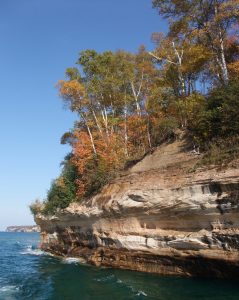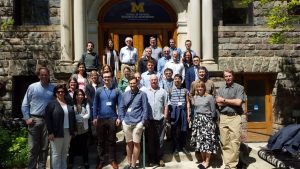The Superior Challenge
Forecasting the Impacts of a Strong El Niño on the World’s Largest LakeDates: May 17-19, 2016
Leads: Branko Kerkez, University of Michigan; Peter Blanken, University of Colorado-Boulder; John Lenters, LimnoTech; Chris Spence, Environment Canada; Drew Gronewold, NOAA GLERL
GLERL Research Program: Integrated Physical and Ecological Modeling and Forecasting

Description: We are coming out of one of the strongest El Niño events in modern history. In the Great Lakes region, El Niño winters are typically warm, with below-normal ice cover on the Great Lakes and warm water temperatures during the subsequent summer. 2015 was no exception, with record-warm air temperatures and below normal Great Lakes ice coverage. The strongest previous El Niño occurred in 1997-98 and has been associated with a regime shift in Lake Superior ice cover, water temperature, and evaporation. Water levels on the Great Lakes remained below normal for many years following the 1998 event, and in many ways these warm, El Niño years may serve as useful and informative proxies for the impacts of climate change on the Great Lakes.
In the interest of advancing NOAA’s mission to improve models and forecasting for the Great Lakes, CILER hosted a spring 2016 summit that brought together a critical mass of Great Lakes researchers and practitioners to forecast and validate the impacts of the 2015-16 El Niño on Lake Superior. The motivation for focusing on Lake Superior was: 1) It is one of the most rapidly warming lakes in the world (and the most rapid of the Great Lakes), 2) It is the deepest of the Great Lakes, with significant thermal memory, and likely to see the strongest response to the current El Niño, 3) Existing evaporation observations (and many modeling efforts) are most strongly concentrated on Lake Superior, 4) Focusing on a single Great Lake allows for a concentrated, efficient approach, and 5) Lessons learned from Lake Superior are applicable to other large-lake systems.
The “Superior Challenge” forecast was intended to incorporate both qualitative predications and quantitative modeling – extending all the way “from the physics to the fish” – and will include forecasted impacts on the following:
• Winter ice cover
• Summer water temperature
• Evaporation
• Lake levels
• Ecosystem impacts
• Societal impacts
Goals: The overall goal of the Superior Challenge Summit was to use the extreme 2015-16 El Niño event to advance NOAA’s mission to improve models and forecasting for the Great Lakes. The intent was to find out how much we – as a Great Lakes research community – truly know about a large-lake ecosystem and its response to a strong external driver, and in turn reveal gaps in knowledge, observations, and models; and these gaps are anticipated to lead to future innovation and improved Great Lakes forecasting capabilities.
2016 Participants
- John Allis, U.S. Army Corps of Engineers
- Jeff Andresen, Michigan State University
- Jay Austin, University of Minnesota-Duluth
- B.J. Baule, Great Lakes Integrated Sciences + Assessments (GLISA)
- Peter Blanken, University of Colorado-Boulder
- Lisa Borre, Cary Institute of Ecosystem Studies
- John Bratton, LimnoTech
- Anne Clites, NOAA GLERL
- Greg Cutrell, LimnoTech
- Jennifer Daley, LimnoTech
- Lauren Fry, U.S. Army Corps of Engineers
- Beth Gibbons, Great Lakes Integrated Sciences + Assessments (GLISA)
- Branko Kerkez, University of Michigan
- Catherine Lapointe, Canada Steamship Lines
- John Lenters, LimnoTech
- George Leshkevich, NOAA GLERL
- Brent Lofgren, NOAA GLERL
- Dendy Lofton, LimnoTech
- Ayumi Manome, University of Michigan-CILER
- Ashley Moerke, Lake Superior State University
- Colleen Mouw, Michigan Tech
- Mike Notaro, University of Wisconsin-Madison
- Sebastiano Piccolroaz, University of Trento, Italy
- Derek Posselt, University of Michigan
- Bob Shuchman, Michigan Tech Research Institute
- Chris Spence, Environment and Climate Change Canada
- Allison Steiner, University of Michigan
- Bob Sterner, University of Minnesota-Duluth
- Steve Vavrus, University of Wisconsin-Madison
- Mark Vinson, U.S. Geological Survey-Ashland
- Jia Wang, NOAA GLERL
- Pengfei Xue, Michigan Tech
- Angela Yu, Michigan Tech
Products: Lenters, J. D., P. D. Blanken, and B. Kerkez (2016), Predicting a Great Lake’s response to a warm winter, Eos, 97,doi:10.1029/2016EO062499. Published on 11 November 2016.

